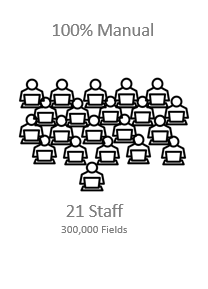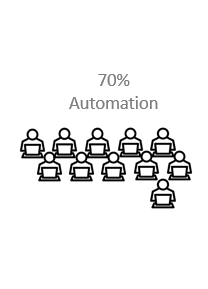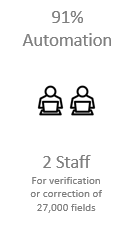Automation: Impacts on Labor
I recently came across a great article from Sloan Management Review discussing the hype around automaton and the impact on labor. In it, a statement caught my eye: “Labor productivity growth, a measure highly correlated with automation, has significantly slowed in recent years. Between 2010 and 2019, it grew less than 1% annually — a historically slow pace, and well below the 3% rate from 1995 to 2005.”
In an age where we’ve seen in the last ten years a number of venerable industries and companies wither in the face of modern, tech-savvy, automated rivals, how could automation’s impact on productivity not have been greater?
Document Automation Industry and Productivity Growth
But then I started thinking about our own document automation industry and wondered if there is a parallel. The answer is a definitive, “yes.” Most organizations using Intelligent Capture/Intelligent Document Processing are probably unaware.
The reason is pretty simple once you can see it.
 Let me illustrate using three different organizations each with the same process. In this process, each receives 30,000 pages per day that have 10 fields, which need to be entered into a system of record. The first is running processes that are fully manual. Document classification, separation, and data extraction are handled by about two dozen staff.
Let me illustrate using three different organizations each with the same process. In this process, each receives 30,000 pages per day that have 10 fields, which need to be entered into a system of record. The first is running processes that are fully manual. Document classification, separation, and data extraction are handled by about two dozen staff.
 Intelligent Capture solutions were supposed to solve that problem by automating these tasks. And they did. As you can see with the organization using Intelligent Capture, over 70% of tasks were automated while reducing the staff required by almost half. A fifty percent reduction of effort is significant, but organizations have essentially been “stuck” in this mode for the last two decades.
Intelligent Capture solutions were supposed to solve that problem by automating these tasks. And they did. As you can see with the organization using Intelligent Capture, over 70% of tasks were automated while reducing the staff required by almost half. A fifty percent reduction of effort is significant, but organizations have essentially been “stuck” in this mode for the last two decades.
The reason is straightforward: while the tasks themselves can be automated to a high degree, the results of each task have traditionally required manual review. This means that rather than perform data entry, staff are mostly reviewing what was automatically entered. This is largely due to the fact that most Intelligent Capture systems cannot support reliably determining good data from bad data. The systems are just too complex to tune, or they don’t have a high enough reliability to be useful. As a result, all the results must be reviewed.
Applying Machine Learning
Yet in the age where we now have very adept machine learning algorithms, we should be able to do much better. The machines should be able to automatically configure systems and optimize them. Additionally, they must understand the difference between correct answers – which require no review – from answers that require review. Such a system would offer 91% automation.
This organization uses software that automatically configures itself using sample data and can learn what output is accurate and what is not. It can also automatically adjust output to meet stringent service level requirements for specific accuracy levels. And it can do all of this with little involvement from technical staff.
Intelligent Capture that utilizes machine learning in the proper way should be easy to configure and deploy and provide high levels of performance. It should provide a level of performance that can really move automation to the highest levels of efficiency. That’s intelligent.
If you found this article interesting, you may find this eBook useful, Automation Strategies for High Variance Documents.



